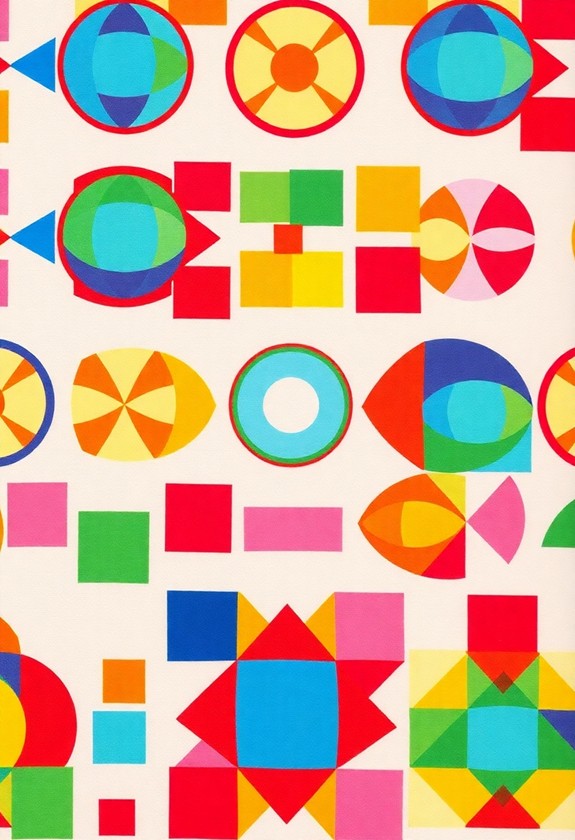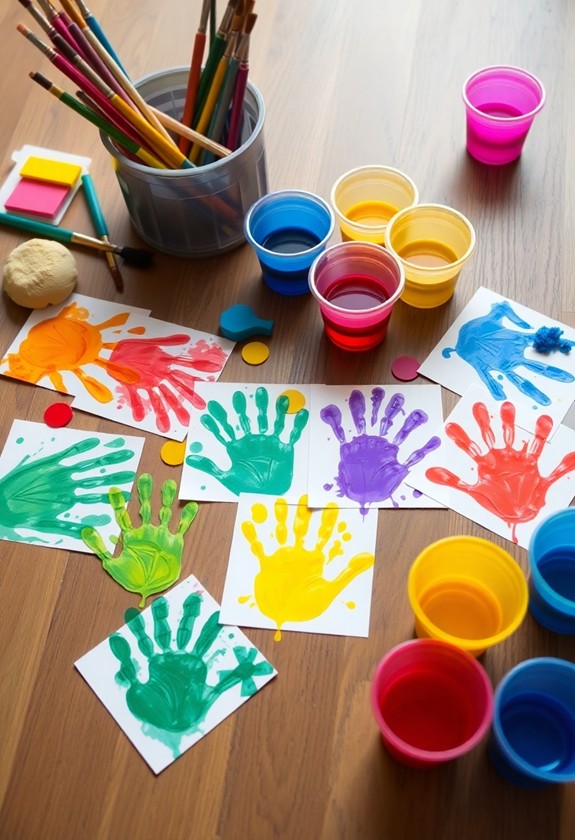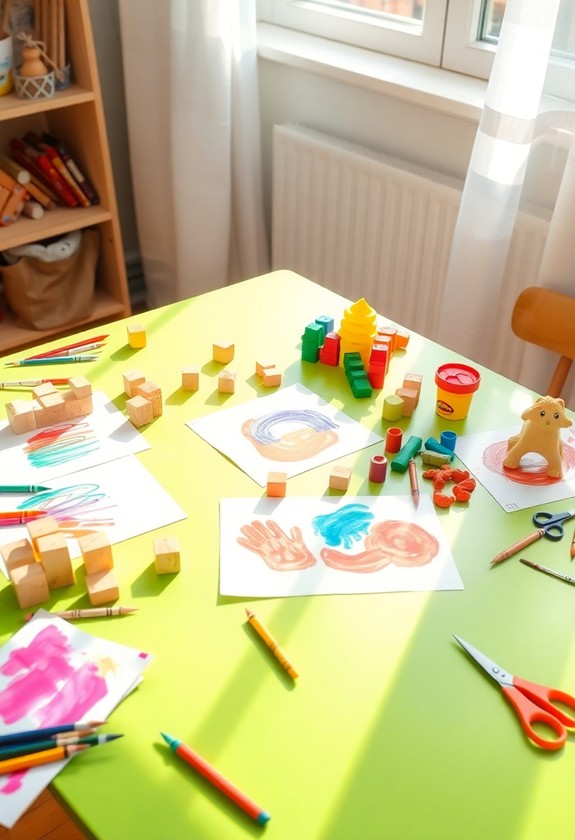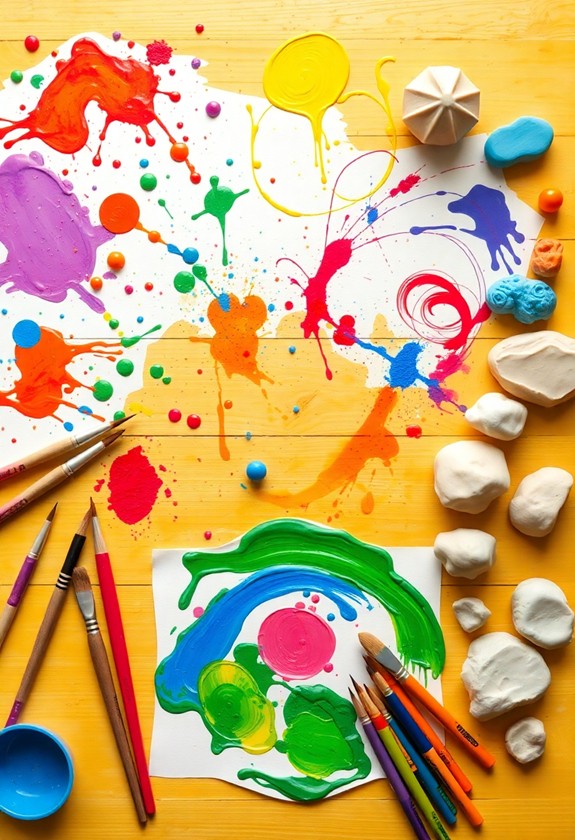Art repetition is a brain-boosting bonanza for your preschooler! It sharpens pattern recognition and recall, making their minds like little memory machines. Through fun activities, they'll master sequencing and ordering skills, becoming mini-organizers. Visual memory gets a colorful workout, as auditory processing improves with artsy sounds and discussions. Muscle memory development turns them into fine-motor maestros! Plus, their cognitive flexibility expands, making them mental gymnasts. And don't forget attention span – it grows longer with each artistic adventure! These seven super-skills aren't just for art time; they're life-long learning superpowers. Ready to unlock your child's full potential?
Creative Highlights
- Pattern recognition and recall skills improve through repeated exposure to colorful shapes and sequences in art.
- Visual memory is reinforced, strengthening neural pathways and enhancing recognition of letters, numbers, and faces.
- Sequencing and ordering abilities develop as preschoolers engage in repetitive art activities and follow step-by-step instructions.
- Muscle memory for fine motor skills is enhanced through regular practice of drawing, cutting, and molding.
- Attention span expands as children complete patterns and engage in focused activities like mandala coloring.
Pattern Recognition and Recall

Through repeated exposure to patterns in art, preschoolers develop crucial memory skills. It's amazing how their little brains work! When you introduce them to colorful shapes, lines, and sequences in artwork, you're actually helping them build pattern recognition abilities. And guess what? These skills are super important for memory development! Craft kits like the Arts and Crafts Supplies Kit with over 1450 items can provide diverse materials for creating patterns and enhancing memory skills. These activities not only promote creativity but in addition contribute to cognitive development.
Here's how it works:
- Kids start noticing repeating elements in art
- They predict what comes next in a pattern
- Their brains practice remembering and recalling information
The more they engage with artistic patterns, the stronger their recall becomes. It's like a fun workout for their minds! You can even make a game out of it. Ask them to spot patterns in paintings or create their own repeating designs. Before you know it, they'll be pattern pros with mighty memory muscles!
Sequencing and Ordering Skills

Developing sequencing and ordering skills through art repetition is another crucial aspect of preschoolers' cognitive growth. You'll be amazed at how quickly your little ones pick up these skills! Through fun, repetitive art activities, they'll learn to:
- Arrange objects in a specific order
- Understand "before" and "after"
- Follow step-by-step instructions
Eco-friendly crafting options can improve these skills as well as promoting environmental awareness. Using recycled materials for sequencing activities adds an extra layer of learning.
It's like magic! Watch as your child creates a colorful masterpiece as they boost their brainpower. Try these exciting exercises:
- Make a pattern with shapes or colors
- Create a story sequence with drawings
- Build a tower following a specific order
But wait, there's more! These activities don't just improve memory – they're a blast! Your child will be having so much fun, they won't even realize they're learning. So grab those art supplies and get ready for some sequencing shenanigans!
Visual Memory Reinforcement

Visual memory reinforcement is a key benefit of art repetition for preschoolers. When kids repeat art activities, they're building their ability to remember visual details. It's like a superpower for their little brains! Multi-sensory experiences during crafting aid in memory retention and information processing, essential for early childhood development. Regular crafting stimulates brain regions associated with problem-solving, creativity, and motor skills.
Here's how it works:
- Each time they draw a shape or color a picture, they're strengthening neural pathways.
- The more they practice, the better they get at recalling visual information.
You'll see amazing results! Your preschooler might suddenly remember:
- The exact shade of blue they used for the sky last week
- The intricate pattern they created on a butterfly's wings
And guess what? This skill isn't just for art! It'll help them:
- Recognize letters and numbers
- Remember faces and places
- Even improve their problem-solving abilities
Auditory Processing Improvement

As visual memory gets a boost from art repetition, it's not the only sensory skill that benefits. Your preschooler's ears are in for a treat too! Auditory processing improves as kids engage in art activities with repetitive elements.
Here's how it works:
- Rhythm and rhyme: Singing songs during creating art helps tune those little ears!
- Sound effects: Encourage your child to make noises that match their artwork. Swoosh! Splat! Bang!
- Verbal instructions: Repeating step-by-step directions reinforces listening skills.
- Art discussions: Talk about colors, shapes, and textures to build vocabulary.
You'll be amazed at how quickly your child's listening abilities sharpen! They'll become better at following directions, distinguishing sounds, and processing language. It's like giving their ears a workout as their hands are busy creating masterpieces. Now that's what we call a win-win situation!
Muscle Memory Development

The magic of muscle memory unfolds as preschoolers engage in repetitive art activities. You'll be amazed at how quickly their little hands learn to master various techniques! As they practice drawing shapes, cutting paper, or molding clay, their muscles are building memories of these movements. This fine motor skill development is essential for later academic success and supports cognitive growth through engaging, hands-on activities.
Watch in awe as your preschooler's fine motor skills improve with each artistic session. They'll soon be:
- Holding pencils with confidence
- Cutting along lines with precision
- Manipulating small objects like a pro
But that's not all! This muscle memory development extends beyond art time. You'll notice improvements in:
- Handwriting
- Buttoning clothes
- Tying shoelaces
Isn't it incredible? Through fun, repetitive art activities, your child is unlocking a world of physical skills. So, grab those crayons and let the muscle memory magic begin!
Cognitive Flexibility Enhancement

Though muscle memory builds physical skills, repetitive art similarly sharpens your preschooler's mental agility. It's like a brain workout! Your little one's mind becomes more flexible as they try different ways to create the same art piece. They'll learn to:
- Switch between ideas quickly
- Adapt to new challenges
- Think outside the box
This creative expression also improves problem-solving and critical thinking skills, setting a foundation for future learning. Wow! Isn't that amazing? As your child repeats art activities, they're not just doodling – they're developing cognitive superpowers! They'll become master problem-solvers, ready to tackle any obstacle. And here's the best part: this flexibility carries over to other areas of life. From figuring out puzzles to handling changes in routine, your preschooler will be a pro at thinking on their feet. So, grab those crayons and get ready for some mind-bending fun!
Attention Span Expansion

Imagine your preschooler's attention span stretching like a rubber band with each repetitive art activity. It's amazing to watch! As they focus on repeating patterns or colors, their concentration grows stronger. You'll see them sitting still for longer periods, totally absorbed in their masterpiece.
Here's how it works:
- Repetitive actions build focus muscles
- Each completed pattern boosts confidence
- Success encourages longer attention spans
Try these attention-boosting art activities:
- Mandala coloring
- Bead stringing
- Finger painting patterns
Watch as your little one's ability to concentrate skyrockets! They'll be tackling bigger projects in no time. And the best part? This improved attention span carries over to other areas of learning. From listening to stories to solving puzzles, your preschooler will be a focusing superstar!
Curious Little Questions
How Does Art Repetition Affect Preschoolers' Emotional Development?
Art repetition is awesome for preschoolers' emotional growth! When kids repeat artistic activities, they're building confidence and self-esteem. It's like a superpower! They'll feel proud of their creations and excited to try again. Plus, it's a great way to express feelings and manage emotions. You'll see them get better at focusing, staying calm, and even working with others. It's not just fun, it's emotionally boosting too! Art repetition is a win-win for little ones' hearts and minds!
Can Art Repetition Help Children With Learning Disabilities?
Did you know that art therapy can improve cognitive skills by up to 30% in children with learning disabilities? That's amazing! If you're wondering about art repetition, you're in for a treat! It can absolutely help kids with learning challenges. Here's why:
- Builds confidence through mastery
- Improves focus and attention span
- Improves fine motor skills
- Boosts memory and recall
Art repetition is like a superpower for learning! It's fun, engaging, and can work wonders for children who struggle in traditional learning environments. Give it a try!
What Role Do Parents Play in Supporting Art Repetition at Home?
You, as a parent, play an essential role in supporting art repetition at home! Here's how you can make it fun and effective:
- Set up a dedicated art space
- Stock up on varied art supplies
- Create a routine for daily art time
- Join in and make art together
- Display your child's creations proudly
- Encourage experimentation with different techniques
Are There Any Potential Drawbacks to Excessive Art Repetition for Preschoolers?
Although art repetition is awesome, too much of a good thing can have drawbacks. Watch out for:
- Boredom: Kiddos might lose interest if it's always the same-old, same-old!
- Stifled creativity: Repeating too much might limit their imagination.
- Perfectionism: They could get frustrated trying to make every piece "perfect."
- Neglecting other skills: Don't forget about other important areas of development!
Balance is key! Mix it up with different activities and let their creativity soar. Remember, variety is the spice of life – even for preschoolers!
How Does Art Repetition Compare to Other Memory-Enhancing Activities for Preschoolers?
Art repetition is awesome for preschoolers, but it's not the only memory-boosting game in town! You've got tons of fun options:
- Puzzles: They're brain-teasers that'll keep kids engaged!
- Memory card games: Flip, match, and remember!
- Storytelling: Let their imaginations run wild!
- Singing songs: Music's a memory miracle!
Although art repetition is fantastic, mixing it up with these other activities can give your little one's memory a super-charged workout. It's all about finding what works best for your child and having a blast during learning!




